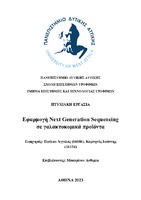| dc.contributor.advisor | Batrinou, Anthimia | |
| dc.contributor.author | Παύλου, Άγγελος | |
| dc.contributor.author | Κομνηνός, Ιωάννης | |
| dc.date.accessioned | 2023-07-21T06:45:57Z | |
| dc.date.available | 2023-07-21T06:45:57Z | |
| dc.date.issued | 2023-07-06 | |
| dc.identifier.uri | https://polynoe.lib.uniwa.gr/xmlui/handle/11400/4760 | |
| dc.identifier.uri | http://dx.doi.org/10.26265/polynoe-4598 | |
| dc.description.abstract | Η εφαρμογή των τεχνολογιών αλληλούχισης επόμενης γενιάς (NGS) έχει αναδειχθεί ως ένα ισχυρό εργαλείο για την ανάλυση δειγμάτων τυριού, φέρνοντας επανάσταση στον τομέα της μικροβιολογίας και της γονιδιωματικής του τυριού. Το τυρί, ένα σύνθετο και ποικιλόμορφο γαλακτοκομικό προϊόν, επηρεάζεται από μυριάδες μικροοργανισμούς που διαδραματίζουν κρίσιμο ρόλο στην παραγωγή, την ανάπτυξη της γεύσης και την ποιότητά του. Οι παραδοσιακές μέθοδοι που βασίζονται σε καλλιέργειες έχουν προσφέρει πολύτιμες γνώσεις, αλλά είναι περιορισμένες ως προς την ικανότητά τους να καταγράφουν την πλήρη μικροβιακή ποικιλομορφία που υπάρχει στο τυρί.
Η NGS επιτρέπει την ολοκληρωμένη και υψηλής απόδοσης ανάλυση των μικροβιακών κοινοτήτων του τυριού με την αλληλουχία του γενετικού υλικού που εξάγεται από τα δείγματα. Οι μεταγονιδιωματικές προσεγγίσεις παρέχουν μια ολιστική εικόνα της μικροβιακής ποικιλότητας, επιτρέποντας την ταυτοποίηση και τον χαρακτηρισμό βακτηρίων, ζυμών, μούχλας και των λειτουργικών γονιδίων τους, καθώς και την ανίχνευση LAB (Lactic Acid Bacteria) βακτηρίων και προβιοτικών πολύτιμων για την ανθρώπινη υγεία. Μέσω της NGS, οι ερευνητές μπορούν να διερευνήσουν τη σύνθεση, τη δυναμική και τις αλληλεπιδράσεις αυτών των μικροβιακών πληθυσμών, ρίχνοντας φως στο ρόλο τους στην παραγωγή τυριού, την ωρίμανση και τα οργανοληπτικά χαρακτηριστικά.
Στην παρούσα μελέτη θα χρησιμοποιήσουμε την τεχνολογία NGS προκειμένου να καταγράψουμε την εικόνα του μικρβιώματος διαφορετικών δειγμάτων ανθότυρου Ελληνικής παραγωγής. Στόχος μας είναι να κατανοήσουμε το βακτηριακό αποτύπωμα ενός προϊόντος το οποίο θεωρείται χαρακτηριστικά ευαλλοίωτο και να μελετήσουμε τη συμπεριφορά των μικροοργανισμών που συνυπάρχουν στο περιβάλλον του ανθότυρου και το πώς οι μεταξύ τους αλληλεπιδράσεις επηρεάζουν την τελική μορφή του προϊόντος, αλλά και τα οργανοληπτικά του χαρακτηριστικά. | el |
| dc.format.extent | 84 | el |
| dc.language.iso | el | el |
| dc.publisher | Πανεπιστήμιο Δυτικής Αττικής | el |
| dc.rights | Αναφορά Δημιουργού - Μη Εμπορική Χρήση - Παρόμοια Διανομή 4.0 Διεθνές | * |
| dc.rights | Attribution-NoDerivatives 4.0 Διεθνές | * |
| dc.rights | Attribution-NoDerivatives 4.0 Διεθνές | * |
| dc.rights | Attribution-NoDerivatives 4.0 Διεθνές | * |
| dc.rights | Attribution-NoDerivatives 4.0 Διεθνές | * |
| dc.rights.uri | http://creativecommons.org/licenses/by-nd/4.0/ | * |
| dc.subject | NGS | el |
| dc.subject | Anthotyros | el |
| dc.subject | Genetic fingerprint | el |
| dc.title | Εφαρμογή Next Generation Sequencing σε γαλακτοκομικά προϊόντα | el |
| dc.title.alternative | Application of Next Generation Sequencing in dairy products | el |
| dc.type | Πτυχιακή εργασία | el |
| dc.contributor.committee | Κοντελές, Σπυρίδων | |
| dc.contributor.committee | HOUHOULA, DIMITRA | |
| dc.contributor.faculty | Σχολή Επιστημών Τροφίμων | el |
| dc.contributor.department | Τμήμα Επιστήμης και Τεχνολογίας Τροφίμων | el |
| dc.description.abstracttranslated | The application of next-generation sequencing (NGS) technologies has emerged as a powerful tool for the analysis of cheese samples, revolutionising the field of cheese microbiology and genomics. Cheese, a complex and diverse dairy product, is influenced by myriad microorganisms that play a critical role in its production, flavour development and quality. Traditional culture-based methods have provided valuable insights, but are limited in their ability to capture the full microbial diversity present in cheese.
NGS allows for a comprehensive and high-throughput analysis of the microbial communities in cheese by sequencing the genetic material extracted from the samples. Metagenomic approaches provide a holistic view of microbial diversity, allowing the identification and characterisation of bacteria, yeasts, moulds and their functional genes, as well as the detection of LAB (Lactic Acid Bacteria) bacteria and probiotics valuable for human health. Through NGS, researchers can investigate the composition, dynamics and interactions of these microbial populations, shedding light on their role in cheese production, ripening and sensory characteristics.
In the present study, we will use NGS technology in order to observe the microbiome of different Greek-produced anthotyros cheese samples. Our aim is to collect and process the data of the bacterial genetic fingerprint of a product that is considered to be especially sensitive to microbial spoilage. We will also study the behaviour of microorganisms that coexist in the anthotyros’ environment and how their interactions affect the final form of the product and its organoleptic characteristics. | el |



